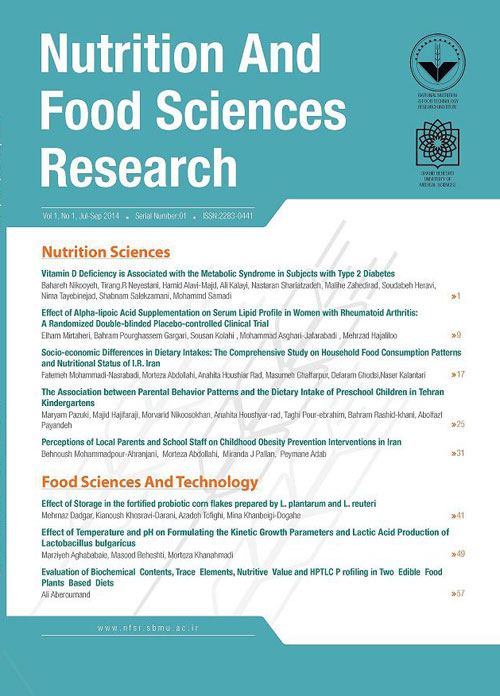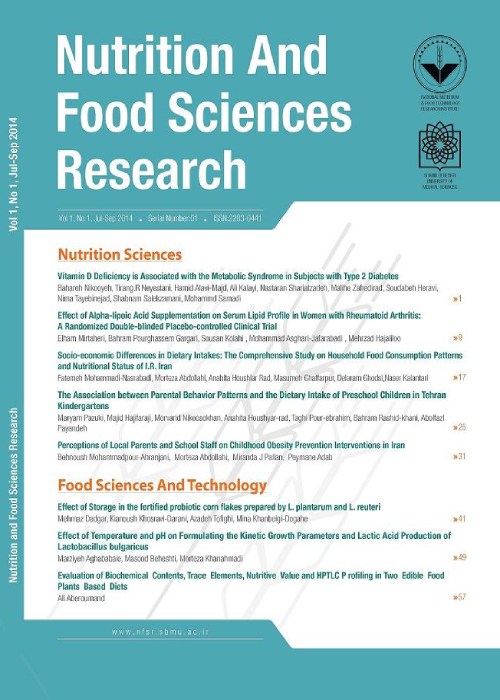فهرست مطالب

Nutrition & Food Technology Research
Volume:3 Issue: 2, Apr-Jun 2016
- تاریخ انتشار: 1395/02/26
- تعداد عناوین: 7
-
-
Pages 3-10Cash transfer (CTs) is an increasingly popular social protection mechanism used by many developing countries to improve the food security and nutritional status of lower socio-economic groups.
This paper is a review of the literature regarding the impact of CT programs on the food security of recipient households in the developing countries, including Iran. We looked for all original studies, performed in the developing countries and published in any language, containing at least one outcome related to food and nutritional security of the beneficiary population using Pub Med, Iran Medex, SID (Scientific Information Database), ISI (Information Sciences Institute) database, INP (Irans Nutrition Publication) Abstracts, IRANDOC and Magiran. Searches used the following terms or keywords: household food security, household food insecurity and cash transfer on any publication published within 1990-2015.
A total of 12 studies evaluating the influence of CT programs on the recipients food and nutrition security were identified. CT programs have the potential to deliver a range of benefits not only through reducing extreme poverty but also by providing effective support for broader human development objectives, including better nutrition, as well as health and education outputs and outcomes. The extent to which programs can have these different impacts will depend critically on the availability of complementary services, the local context, and the specifics of program design, including the transfer value. However, findings in Iran suggest that the replacement of staple food subsidies by CT has led to a significant increase in household food insecurity (especially marginal or mild food insecurity).Keywords: Household food security, Cash transfer, Developing countries -
Pages 11-20Background And ObjectivesPeriodontal disease is a chronic disorder with a high prevalence. There are few studies about the role of diet in prevention and treatment of periodontal disease. The aim of this study was to evaluate the effect of consumption of Chicory leaf extract in adjunct with non-surgical periodontal therapies on serum antioxidant and lipid status.Materials And MethodsThis study was a double-blind, randomized controlled clinical trial conducted on 40 patients in Sina Hospital of Ahvaz Jundishapur University of Medical Sciences (Iran) in 2014. The intervention (n=20) and control groups (n=20) were allocated using blocked randomization. The intervention group received 2 capsules (2 g) of Chicory leaf extract daily for 8 weeks. All subjects underwent non-surgical periodontal therapy during the intervention period. Anthropometric indices, 24-hour diet records, total antioxidant capacity, malate di-aldehyde (MDA), uric acid, total cholesterol, triglyceride (TG) and HDL-c was measured before and after intervention.ResultsThe mean level of total antioxidant capacity (1.89 ± 0.49; 1.20 ± 0.25, respectively; PConclusionsIt seems that consumption of Chicory leaf in adjunct with non-surgical periodontal treatment has beneficial effect against periodontal disease.Keywords: Periodontal disease, Chicory, Total antioxidant capacity, Inflammation, Lipid
-
Pages 21-26Background And ObjectivesGlobally, the prevalence of overweight/obesity is increasing at an alarming rate. According to the World Health Organization (WHO), about 1.9 billion adults worldwide are overweight, and of these, over 600 million are obese. The purpose of this study was to determine the prevalence of overweight and obesity in West Azerbaijan, Iran, in 2014.Materials And MethodsData were collected as part of the National Food and Nutritional Surveillance Program (NFNSP). A total of 249 men and women aged 2060 from West Azerbaijan were included in the survey conducted in 2014. Body height and weight were measured with light clothing and no footwear after overnight fasting.ResultsMean age of the participants was 38.5 ±7.8 yrs. Mean BMI was 28.0±4.9 kg/m2 (men: 26.8±4.2 vs. women: 29.0±5.3, pConclusionsThe high prevalence of weight problems in West Azerbaijan is a serious health concern, especially in women. The lifestyle of housewives is a potential risk factor for weight gain in women.Keywords: Obesity, Prevalence, Azerbaijan, Adults
-
Pages 27-34Background And ObjectivesRed beet extract concentrate can be used as a natural colorant in food products; however, destructive effects of thermal methods to produce juice concentrate decrease nutritional value in the final product.Materials And MethodsIn this study, red beet extract was concentrated using osmotic distillation method, and the best pretreatment was evaluated to increase the efficiency of the concentration process. Also changes in some physicochemical properties such as betacyanins and betaxanthins contents, total phenolic compounds and antioxidant activity of red beet juice were evaluated by both the membrane and thermal concentration methods.ResultsThe results showed that the best concentration efficiency was obtained after pretreatment of the fresh juice with centrifugation at 1699 G for 17 min. Evaluation of the effect of both the membrane and thermal concentration processes on the physicochemical properties of juice showed that the membrane method did not change betacyanin and betaxanthin contents, total phenolic compounds, and antioxidant activity of the red beet extract. However, these properties decreased with the thermal concentration method by 26, 15, 11 and 13%, respectively.ConclusionsAccording to the results, osmotic distillation can produce red beet concentrate with more nutritional value than the concentrate produced with thermal method.Keywords: Membrane, Natural betalain colorant, Osmotic distillation, Red beet
-
Pages 35-42Background And ObjectivesEssential oils (EOs) possess a wide range of significant properties including antiphlogistic, spasmolytic and antinociceptive effects. In this study, we use EOs from Thymus daenensis, Thymus caramanicus and Ziziphora clinopodiodes.Materials And MethodsIn this study, the plants were collected from the Botany Department, were air dried, grinded and set for extraction with a Clevenger-type apparatus, according to the procedure described in the European pharmacopoeia. In vitro antifungal activity of the EOs was evaluated according to Agar dilution method by determining the radial growth rate and inhibition ratio (%).ResultsAmong the three EOs, T. daenensis contains the highest level of thymol (77.62%). Zizipora clinopodioides contains pulegone (31.21%), menth-3-en-8-0l (23.82%), menthol (7.21%), borneol (2.25%), carvacrol (5.38%) and piperitone (5.55%). Only the 9 µL concentration of Z. clinopodioides EO can prevent mycelium growth of both fungi for 7 days. Thymus caramanicus contains carvacrol (65.52%), p-cymene (13.21%), gamma-terpinene (4.44%), thymol (4.14%) and linalool (2.63).ConclusionsAccording to the results, that compound thymol is more effective than carvacrol in preventing the growth of fungi.Keywords: Essential oils, Aspergillus flavus, Aspergillus parasiticus, Natural antifungal
-
Pages 43-50Background And ObjectivesHigh concentration of preservatives in food may result in gastrointestinal disturbances whereby some patients suffering from asthma, rhinitis, or urticaria. The aim of this study is the introduction and optimization a new method for simultaneous determination of four preservatives (SB, PS, MP, PP) in foodstuff by high performance liquid chromatography.Materials And MethodsImportant factors in extraction, separation and determination process were optimized using the one variable at a time method. Figures of merit of the proposed method were evaluated. The amount of SB, PS, MP, PP in some food samples were determined using the proposed method.ResultThe results showed that the obtained chromatogram of extract was free of significant interferences. The preservatives recoveries ranged from 88% to 110 %. Concentration of SB, PS, MP and PP in the 20studied samples ranges between N.D-639.9, N.D -214.5, N.D -579.8 and N.D -30.5 mg kg-1, respectivelyConclusionThe performance and reliability of proposed method as a simple, efficient and fast method for determination of SB, PS, MP, PP in the food samples was demonstrated.Keywords: Sauce samples, Sodium benzoate, Potassium sorbate, Parabens, High performance liquid chromatography (HPLC)


